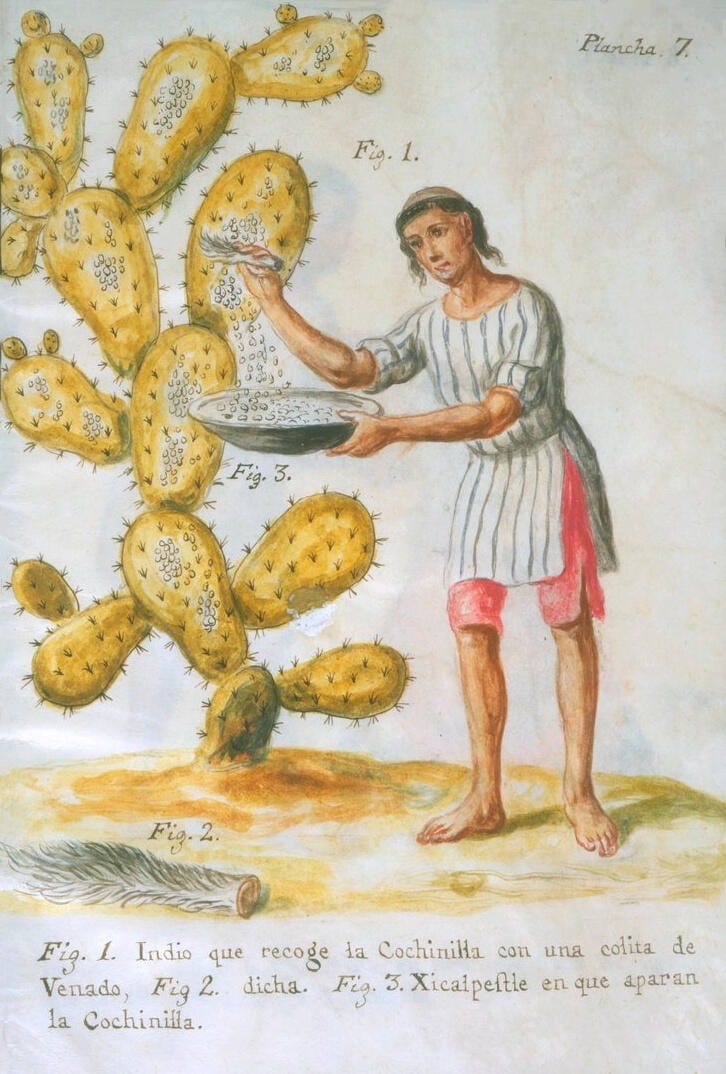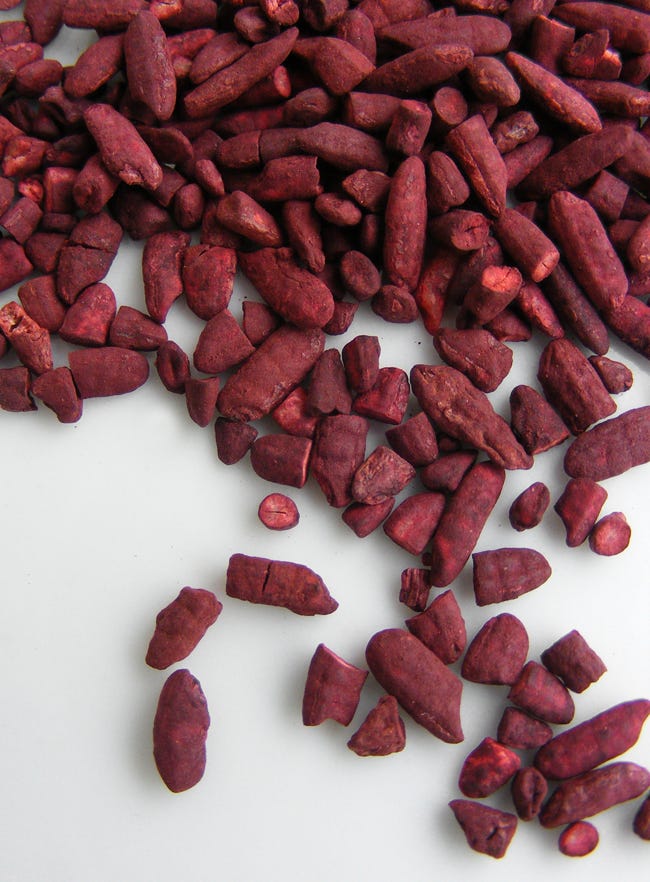The Flavor of Red
The FDA banned Red no. 3 this week, causing millions to ask: "Why in the world a do we need food dye anyway?" But the truth is, the color red has a kind of flavor, and we can't get enough of it.
The Italians say, “Si mangia prima con gli occhi”, which is, “You eat with your eyes first”. It’s a clever saying, and most people toss it off lightly. But it reveals a very deep truth about how we experience flavor.
We’re taught as children that we have five senses; sight, smell, sound, touch, and hearing. This conception goes back to Aristotle, and is a fundamental concept in the study of human perception. However, there is a problem: conceiving of these senses as separate and independent modes of sensation is misleading- in truth, these senses are always experienced in concert with the others. For example, we see a flower at the same moment as we smell it; we hear the crunch of a leaf as we feel it crumble in our hand. We experience the world in multi-sensory terms.
And it goes a step further: because of the way our brains work, multisensory information has a way of interacting in the brain in some very interesting ways. This is a phenomenon well known to neuroscience: information from one sense can influence the perception of other senses dramatically. This has come to be called crossmodalism, and has been a rich area of neuroscientific study over the past decade. Studies have shown that a felt texture- say, a piece of sandpaper held in the hand- will affect how a food feels in your mouth, a phenomenon called sense transference. This is why soda from a can tastes different than soda in a glass, and why food tastes better when eaten in a beautiful setting. Our senses combine to amplify or dampen each other, making human experience complex, multifaceted and, most importantly, multi-sensory.
And so it is with color and flavor. In evolutionary history, our species learned that colors are associated with flavor and nutrition: green fruits are likely to be sour, but orange and red ones are likely to be sweet. Meat cooked until black is likely to be bitter, while white milk is creamy. And one of the deepest associations we have in food is the color red.
my daughter Suzy picks a strawberry
Apples, cherries, raspberries, grapes, pomegranates, watermelons, currants, and strawberries all signal their ripeness and sweetness with the color red. And it’s not a single pigment: carotenoids, anthocyanins, and betacyanins are just three of the various chemical groups that turn plants various shades of crimson, scarlet, and ruby. This signaling performs an important evolutionary function: many plants rely on animals to reproduce, and they provide sweet, red fruits to tempt them to consume and spread seeds via their excrement. A red fruit is a positive clue to an animal- “eat me”, the color says: “I’m delicious.” As neuroscientist Fabiana Carvalho explained to me, “The human trichromatic eye has evolved to improve foraging by enhancing the differences between red and green nuances. Red in fruits, leaves, and roots indicate higher energy and/or higher protein content.”
But it’s not just fruit: fresh meat is bright red, but fades into brown as it spoils. This is because of myoglobin, a protein that helps transfer oxygen to muscles. When you cut into a rare steak and see the delicious bright red juices, that’s the myoglobin, and it’s an indication the meat is fresh. The myoglobin contains iron, and as the iron oxidizes with age, it loses an electron and becomes brown-colored metamyoglobin. So we identify bright red meat with freshness.
As a result, the visual stimulus of red triggers our senses of taste and smell in at least three ways. First of all, we associate red with sweetness: several neurological studies have shown that red color enhances the perception of sweetness in foods. But red color will also enhance the sensation of spiciness. And, potentially, meaty flavors like umami.
It's certainly for these reasons that humans have taken matters into their own hands and colored their foods red for thousands of years. Here are a few examples:
Cochineal, the Insect Red
It’s pretty tough to impress my kids, but I pulled it off a few weeks ago during a hike in Southern California. We came across a prickly pear cactus that was covered with cottony webs. I asked my kids if they wanted to see a trick as I scraped a bit of that white cottony stuff onto my finger. I squeezed it tight, and suddenly my finger was covered in a brilliant red hue. The kids gasped in surprise. Cochineal, I explained.
Cochineal is a small beetle that lives only on the opuntia cactus, native to Mexico. The little insect covers itself in cottony webs and feeds on the cactus juice. The beetle’s defense mechanism is carminic acid, a powerful deterrent to ants. But carminic acid, when extracted from the insect, produces a brilliant red dye that will permanently stain fibers and foods alike. The ancient Egyptians knew about beetles producing red; they used a species called kermes to dye cloth and food (this is where we get our word “crimson”). But the Mexican cochineal insect is much more powerfully red- and cochineal production became an indigenous industry during the colonial period, the dye exported and used to color cloth and food alike, especially candy.
Still today, we farm these insects to dye our foods: if you see “carmine”, “natural red 4” or “E140” on ingredient lists, it’s cochineal. It’s very common in candies, jellybeans and gummi bears, which is why occasionally you’ll hear a rumor about “ground up bugs” in candies.
Achiote, the lipstick plant
In Central America, there is a shrub called the achiote that bears funny looking fuzzy pods. Open a pod, and you’ll find a bunch of bright red seeds. These seeds are called annatto, and are a brilliant source of red. Indigenous Mesoamericans used it for both cooking and face paint, and it’s still a source of color for both things today. It was often used to make red lipstick, which gave it its name. Today, it’s more often used to color food (look for annatto or achiote on the label). The dish cochinita pibil- pork slow-roasted with achiote- is a classic of Yucatán cuisine, and achiote is used to make all kinds of adobos and stews- both Mexican and Filipino- blazing red.
Cochinita pibil, photo Popo le Chien, Creative Commons
Hong zao, the red rice of China
In traditional Chinese culture, red is an extremely auspicious color, symbolic of joy and good fortune. It’s also associated with fire, heat, and meat. For these reasons, coloring foods red is an extremely appealing idea, and Chinese cooks have been doing it for thousands of years. One way is to use hong zao mi (紅糟米),literally “red rice” which is an extremely special foodstuff. It is rice which has been inoculated with a species of mold, similar to Japanese koji. The mold is brilliant red in color, and a famous red rice wine is made from the inoculated, red rice.
Red yeast rice, photo Glane23, Creative Commons
The leftover lees from that wine are delicious and a deep red, and are used to marinate foods from the Cantonese char siu to Peking duck to the delicious Fujian dish hong zao ji, or red rice wine chicken. A familiar sight to a visitor to any American Chinatown are bright-red char siu pork and roasted ducks hanging in the front window of Chinese barbecue restaurants, a mouthwatering sight indeed. These days, this meat is more likely to be dyed red with food coloring than hong zao- the red rice is expensive and rare and red 40 does a great job of creating that auspicious red look.
roast duck and char siu in shop display, photo MANSINcha, Creative Commons
Here come the Synthetics
By the 19th century, the confectionery industry was growing rapidly, but candymakers would use all sorts of stuff as food colorings. Especially concerning was the use of mercury, copper, and lead. Lead oxide is known as “red lead” and was used in paints, inks- and candy. Of course, lead is a huge problem when it’s consumed- it causes serious brain damage or even death. Realizing this, chemists sought to develop safer chemical dyes for foods. Over the years, several red dyes were developed, but sadly many of them- though safer than metals- were found to be problematic themselves. The formulation FD&C Red no. 1 was banned in 1961 after it was found to be carcinogenic, as was Red no. 2 in 1976. These two bans by the FDA led to a deep distrust of food colors- red especially. I can remember my mom fretting over red food coloring in our foods as kids. The two remaining synthetic red dyes- Red no. 3 and Red no. 40, have proven to be very safe. Concern has never quite left Red no. 3, and though the FDA stipulates that the colorant has never been shown to cause cancer in humans, it has banned it anyway, following similar bans in Europe and California. Now we just have red 40 left to dye our cupcakes, our Easter eggs, and our char siu. Alternatives exist- beet juice, for example- but they don’t have the vibrancy that synthetic colors have: breakfast cereal Trix disastrously introduced natural colors in 2017, and consumers rejected the sickly-looking result.
Point is, we love to eat red things. Seeing red helps us perceive sweetness, helps amp up meaty flavor, and enhances the experience of spices. We’ve used bugs, molds, vegetables, seeds, and synthetic chemicals to color foods, and there is no doubt we’ll keep finding ways to make our foods redder and redder.










Did you notice what the tool used to gather cochineal was? A deer tail!